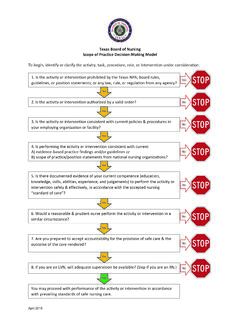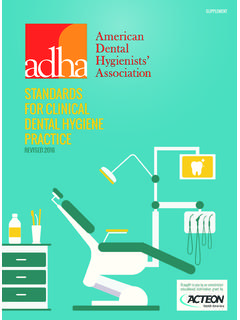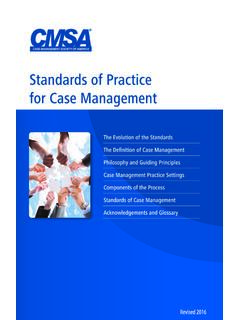Transcription of The Iowa Model of Evidence-Based Practice to Promote ...
1 Clinical Journal of Oncology Nursing Volume 18, Number 2 Evidence-Based Practice 157 The Iowa Model of Evidence-Based Practice to Promote Quality Care: An Illustrated Example in Oncology NursingCarlton G. Brown, PhD, RN, AOCN , FAANE vidence-based Practice (EBP) improves the quality of patient care and helps control healthcare costs. Numerous EBP models exist to assist nurses and other healthcare providers to integrate best evidence into clinical Practice . The Iowa Model of Evidence-Based Practice to Promote Quality Care is one Model that should be considered. Using an actual clinical example, this article describes how the Iowa Model can be used effectively to implement an actual Practice change at the unit or organizational G. Brown, PhD, RN, AOCN , FAAN, is the director of Professional Services at the Oregon Nurses Association in Tualatin. The author takes full responsibility for the content of the article.
2 The author did not receive honoraria for this work. No financial relationships relevant to the content of this article have been disclosed by the author or editorial staff. Brown can be reached at with copy to editor at words: Evidence-Based Practice ; research; decision makingDigital Object Identifier: understand that Evidence-Based Practice (EBP) improves the quality of patient outcomes while controlling the cost of healthcare (Mel-nyk, Fineout-Overholt, Gallagher-Ford, & Kaplan, 2012). But even in the year 2014, barriers and roadblocks exist to imple-menting EBP at the bedside or chair side. The Institute of Medicine estimated that it takes more than 17 years to implement a research finding into clinical Practice (Institute of Medicine, 2001). Although research may exist that should be trans-lated into Practice , the time it takes to deliver these research-based interventions to patients takes too long.
3 In their study of 1,054 RNs, Melnyk et al. (2012) discov-ered that although nurses value EBP, they required education, access to information, and time to implement EBP into daily prac-tice. Nurses and other healthcare provid-ers want their Practice based in evidence, but they also acknowledge the barriers of lack of education and time to actually implement and use EBP. EBP is a problem-solving approach to clinical decision making that integrates the best evidence from well-designed studies with a clinician s expertise along with patients preferences and values (Melnyk et al., 2012). Numerous EBP models are available to help nurses orga-nize and systematically track progress in implementing evidence into Practice , in-cluding the Stetler Model of Research Uti-lization (Stetler, 2001), the Iowa Model of Evidence-Based Practice to Promote Qual-ity Care (hereafter referred to as the Iowa Model ) (Titler et al.)
4 , 2001), and the Johns Hopkins Nursing Model (Newhouse, Dear-holt, Poe, Pugh, & White, 2005). These models provide a step-by-step guide on how to take a clinical problem and match it with an intervention based on research to make an organizational or departmental change to Practice . Using a Model for EBP change also can assist nursing depart-ments in better focusing their limited fiscal and personnel resources on critical EBP activities (Gawlinski & Rutledge, 2008). The current article will focus on one such Model , the Iowa Model (Titler et al., 2001), as an example of how using a Model can help focus on the process of implementing Evidence-Based changes (see Figure 1). The Iowa Model was se-lected because nurses find it intuitively understandable and it has been used in nu-merous academic settings and healthcare institutions (Gawlinski & Rutledge, 2008).
5 Overview of ModelThe Iowa Model can help nurses and other healthcare providers translate re-search findings into clinical Practice while improving outcomes for patients. The first step in the Iowa Model is to iden-tify either a problem-focused trigger or a knowledge-focused trigger where an EBP change might be warranted. Problem- focused triggers are those problems that derive from risk management data, finan-cial data, or the identification of a clinical problem ( , patient falls). Knowledge-focused triggers are those that come forward when new research findings are presented or when new Practice guide-lines are warranted. The next step in the Iowa Model is for the nurse or team to determine whether the problem at hand is a priority for the or-ganization, department, or unit in which they work. Those problems that may have higher volume or higher costs associated likely will have higher priority from the organization.
6 Organizational buy-in is crucial when working on EBP issues, so knowing the prioritization of the problem is important. Once the priority has been determined, the next step is to form a team consist-ing of members that will help develop, evaluate, and implement the EBP change. The composition of the team will be de-termined by the problem at hand. Titler et al. (2001) pointed out that the team should include interested interdisciplin-ary stakeholders. This step is important and should include team players outside of those from nursing. Once a team has been formed, the next step is to gather and critique pertinent research related to the desired Practice change. The most important portion of this step is to form a good question (using the PICOT method [Guyatt, Drummond, Evidence-Based Practice Carlton G.)]
7 Brown, PhD, RN, AOCN , FAAN Associate Editor Oncology Nursing Society. Unauthorized reproduction, in part or in whole, is strictly prohibited. For permission to photocopy, post online, reprint, adapt, or otherwise reuse any or all content from this article, e-mail To purchase high-quality reprints, e-mail 158 April 2014 Volume 18, Number 2 Clinical Journal of Oncology NursingMeade, & Cook, 2008]) and then conduct a literature search for actual research studies that pertain to the question at Form a teamConsider other triggersProblem-Focused Triggers1. Risk management data2. Process improvement data3. Internal/external benchmarking data4. Financial data5. Identification of clinical problemYe sFIGURE 1. The Iowa Model of Evidence-Based Practice to Promote Quality CareNote. Figure courtesy of Marita Titler. Used with this topic a priority for the organization?
8 Critique and synthesize research for use in practiceAssemble relevant research and related literatureIs change appropriate for adoption in Practice ?Continue to evaluate quality of care and new knowledgeInstitute the change in practiceKnowledge-Focused Triggers1. New research or other literature2. National agencies or organizational standards and guidelines3. Philosophies of care4. Questions from institutional standards committeePilot the Change in Practice1. Select outcomes to be achieved2. Collect baseline data3. Design Evidence-Based prac-tice (EBP) guideline(s)4. Implement EBP on pilot units5. Evaluate the process and outcomes6. Modify the Practice guidelinesDisseminate resultsMonitor and Analyze Structure, Process, and Outcome Data Environment Staff Cost Patient and familyNoYe sNoNoYe sIs there a sufficient research base?Conduct researchBase Practice on Other Types of Evidence1.
9 Case reports2. Expert opinion3. Scientific principles4. Theoryhand. This is an excellent time to enlist a medical librarian who can help search for and retrieve studies to aid in choosing an intervention or answer to the problem or knowledge-focused question. The next step is that the team must critique the available studies to deter-mine whether the study with the test-ed intervention is scientifically sound. Not every research article published in a professional journal has appropriate scientific merit. Sometimes articles have a small sample size or perhaps use a tool lacking reliability or valid-ity, so critiquing every article prior to considering the results of that study for implementation into a Practice change is important. Advanced Practice nurses are ideal members of the team to as-sist with the critique of respective research studies (Titler et al.)
10 , 2001). Titler et al. (2001) also suggested pair-ing novice team players with members who are experts or more experienced in critiquing research. At this juncture, the team needs to de-cide whether sufficient research exists to implement a Practice change. Titler et al. (2001) suggested the following cri-teria be considered when determining whether research can be implemented into Practice : (a) consistent findings exist from numerous studies to support the change, (b) the type and quality of the studies, (c) the clinical relevance of the findings, (d) the number of studies with similar sample characteristics, (e) the feasibility of the findings in prac-tice, and (f) the risk-benefit ratio. If a majority of the criteria can be met, the team should then plan to implement the intervention in a pilot Practice change. If adequate research does not exist, an actual research study might be conducted.







